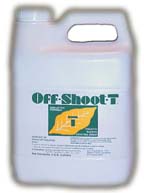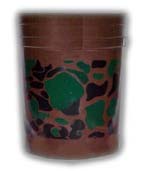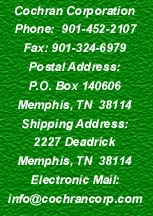Sucker
Control Explained
When you see a primary sucker growing at the
leaf axil, look closely. Below is a tiny second sucker. Not visible is a third.
In other words, at each leaf axil two and maybe three suckers can develop in the
life of a plant. The first and second suckers ... the early suckers ... will usually
appear during the early button the early flower stage. The first suckers, in fact,
may even appear before the early button stage. Suckers
may look quite innocent. After all, they're nothing more than budding tobacco
leaves. But suckers need nutrients and other plant resources to grown. And if
you don't control them they will steal growth from the major leaves (18 to 20
leaves per plant are usually desired for the most profitable yield.) Good tobacco
growers know that good sucker control means increased yield and quantity. Sure,
you can remove suckers by hand. But it's a long, difficult and expensive job.
A job today's modern grower can't afford. Not when early suckers can be chemically
controlled with Off-Shoot-T. Off-Shoot-T
doesn't stop leaf growth. The leaves will continue to develop and mature in the
natural manner. Studies show that one or two applications of Off-Shoot-T followed
by maleic hydrazide provide a higher degree of sucker control than maleic hydrazide
used alone. That's why most growers now use Off-Shoot-T first, then follow with
maleic hydrazide. It's the best combination.
BACK
TO TOP
How
Off-Shoot-T Works
When Off-Shoot-T touches the fast growing suckers,
it kills on contact.
Sprayed overhead, it runs down the tobacco stalk and touches the sucker in the
leaf axil. The suckers starts to turn brown within an hour and, if the chemical
has been applied properly, the sucker is killed. Rundown is extremely important.
Off-Shoot-T runs behind the primary sucker, and when it makes contact with the
secondary sucker that one is also killed or at least slowed down. Remember,
the sucker must be contacted by the chemical solution to be killed. If a leaf
is shielding a sucker or if the spray misses a leaning plant, those suckers not
contact by the spray will continue to grow. Usually though, if the row is straight,
the plant is upright, and the application correct, you will get excellent control.
BACK
TO TOP
The
Best Time to Spray
Time and experience have taught us that the
best time to spray is at the early button stage. Many times a grower will wait
too long to make the first application. And this can cost money Unfortunately,
a field doesn't all come into early button at the same time. That's why you should
use your judgment. Usually you should spray when 70-80% of your field is in early
button. One way to check is to simply walk into a typical part of your field and
count out 10 or 20 plants - if 7 or 8 out of 10 plants are in early button, chances
are your total filed is ready. Some chemical topping of very late maturing plants
is a good indication that your spraying early enough.
BACK
TO TOP
How
often to Apply
One application of Off-Shoot-T often controls the
first and second suckers. A second application needs to be applied within 3 to
5 days of the first application, to control suckers on later maturing plants or
suckers missed due to environmental conditions. The latest research by North Carolina
State University shows the ability to increase top stalk tobacco 13% by applying
a third application when the leaves are 18 inches long. This has produced the
added benefits of less leaf distortion and reduced bronzing.
BACK
TO TOP
Rain,
Wind, Time, Temperature
These, obviously, can affect the performance
of a sucker control chemical. For best results, remember these few key points.
They can help you get better results with Off-Shoot-T. 1.
Rain won't matter if Off-Shoot-T has been on over an hour. If it has been on less
than an hour you may need to reapply the chemical. 2.
Wind can be a problem if it blows the spray away from the plant tops. This can
cause poor rundown of the sucker control chemical. If the wind is turning leaves
over, the more tender back side of the leaf is exposed to possible spray damage.
Blowing leaves also cover suckers, preventing the chemical from reaching and controlling
them. 3.
Don't spray when leaves are wet from dew or irrigations. Such conditions will
only dilute or weaken the strength of Off-Shoot-T. 4.
Don't spray if leaves are wilted from high temperature of lack of moisture.
BACK
TO TOP
What
about Damage?
Obviously, a chemical that can burn out suckers can,
under certain conditions, cause leaf burn. For instance, if it "puddles"
on the leaf. Or if it has been applied to rapidly growing plants after heavy rains
or irrigation. Usually, however, this causes no major problems and the leaves
continue to develop and mature. It's what most growers consider an acceptable
amount of spotting. Some browning may also occur if leaves turn over and the spray
hits the tender back side of the leaf. This may happen during high winds when
it is undesirable to spray and shows up as small droplet size spots. Almost all
tobacco with minor burns will continue to develop with no serious problem.
BACK
TO TOP
Mixing
and Application
The diluted product is easily mixed by adding the
required amount of Off-Shoot-T to the spray tank and then adding the water. For
the best results, it is important that the water be added to the Off-Shoot-T rather
than the Off-Shoot-T to the water. BE SURE TO MIX THOROUGHLY BEFORE SPRAYING.
When using a power sprayer, recirculate the emulsion for several minutes before
spraying. If you use a hand sprayer, shake the tank well before spraying.
BACK
TO TOP
How
much Off-Shoot-T to apply?
Power Sprayer
Flue-Cured: 1 1/2 -
2 gallons in 48 gallons of water
Burley: 1 3/4 -2 gallons in 48 gallons of
water.
This will treat approximately one acre. Apply enough solution so that
it will run down to the bottom of the stalk. Hand
Sprayer
Flue-Cured, Burley and Cigar Tobacco: 4-5 ounces per gallon of water.
(This is one part Off-Shoot-T to approximately 25-32 parts water)
Dark Tobacco:
6-8 ounces per gallon of water. (This is one part Off-Shoot-T to approximately
16-21 parts water)
Maryland Tobacco: 4 - 4 1/2 ounces per gallon of water (This
is one part Off-Shoot-T to approximately 25 -30 parts water.) One gallon diluted
product will treat approximately 190 plants.
BACK
TO TOP
| 


